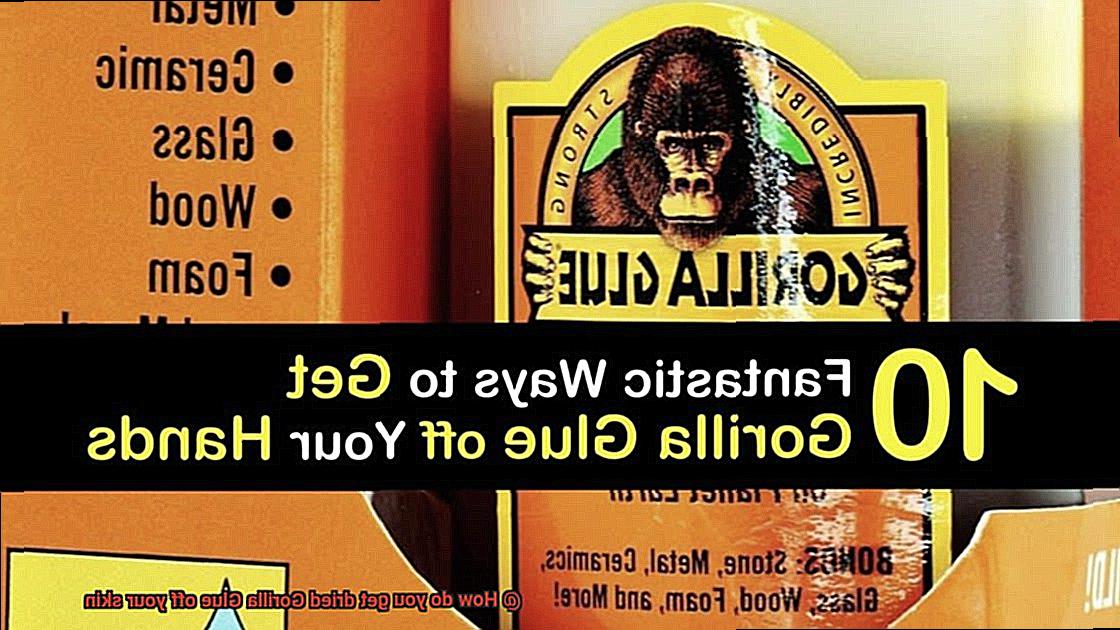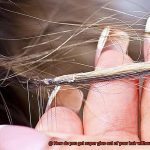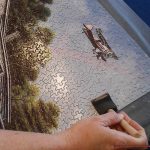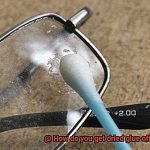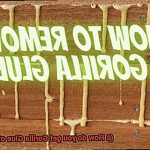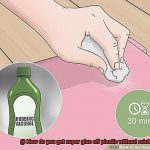Imagine this: you’re knee-deep in a DIY project, happily hammering away, when disaster strikes. One slip of the finger and bam. Dried Gorilla Glue has latched onto your skin like a stubborn leech. Cue the panic as you desperately search for a solution that won’t leave you with battle scars.
But fear not, my fellow glue aficionados. In this nifty guide, we’re about to unravel the mystery of getting rid of dried Gorilla Glue from your skin. Whether you’re a seasoned pro or just an eager DIYer, stick around (pun intended.) as we reveal foolproof methods that’ll save your skin from this sticky situation.
We’ll dive into both conventional and quirky techniques, exploring everything from the tried-and-true to the downright ingenious. So if you’ve ever found yourself trapped between two pieces of rock-hard adhesive, don’t fret – salvation is just a few paragraphs away.
Understanding Gorilla Glue
Contents
- 1 Understanding Gorilla Glue
- 2 Protecting Your Skin From Further Damage
- 3 Removing Dried Gorilla Glue With Acetone
- 4 Alternative Methods for Removing Dried Gorilla Glue
- 5 Taking Precautions When Using Adhesives
- 6 Seeking Professional Medical Advice
- 7 Repeating the Removal Process
- 8 Caring for Your Skin After Removal
- 9 Conclusion
In the world of adhesives, one brand reigns supreme: Gorilla Glue. With its remarkable bonding properties and unique characteristics, this adhesive solution has become a staple in various industries. In this article, we will take an in-depth look at Gorilla Glue, uncovering its secrets and exploring what sets it apart from other types of adhesives.
The Polyurethane-based Marvel:
At the heart of Gorilla Glue lies its polyurethane-based formula, a key factor in its exceptional performance. This glue forms an incredibly strong and durable bond once it dries, making it the go-to choice for long-lasting repairs and projects that demand nothing but the best.
Versatility that Knows No Bounds:
One of the most outstanding features of Gorilla Glue is its unparalleled versatility. This adhesive can be used on a wide range of surfaces, including wood, metal, stone, glass, ceramics, foam, and more. Whether you’re fixing a broken chair or creating a DIY masterpiece, Gorilla Glue has got you covered.
Brave in the Face of Elements:
Gorilla Glue fearlessly defies water and extreme temperatures with its impressive resilience. It is completely waterproof, making it an ideal solution for outdoor projects or areas prone to moisture. Moreover, this adhesive can withstand scorching heat and freezing cold without compromising its bond.
Expanding Horizons, Strengthening Bonds:
When Gorilla Glue encounters moisture during application, it expands and transforms into a foam-like substance. This expansion allows the glue to fill gaps and crevices, creating an even stronger bond. So whether you’re dealing with uneven surfaces or irregular shapes, rest assured that Gorilla Glue will provide a secure hold that leaves no room for doubt.
Patience: A Virtue that Rewards:
Working with Gorilla Glue requires patience, as it takes approximately 24 hours to fully cure and harden. However, this curing time ensures that the glue forms a robust bond that withstands the test of time. So, exercise patience, and let Gorilla Glue work its magic for the ultimate durability.
The Taming of the Mighty Gorilla:
While Gorilla Glue excels in its adhesive properties, removing dried glue from surfaces and skin can be a daunting task. It is important to take precautions to protect your skin and use safe removal methods, such as using acetone or oil. Handle this mighty adhesive with care, and it will reward you with its unmatched strength.
Protecting Your Skin From Further Damage
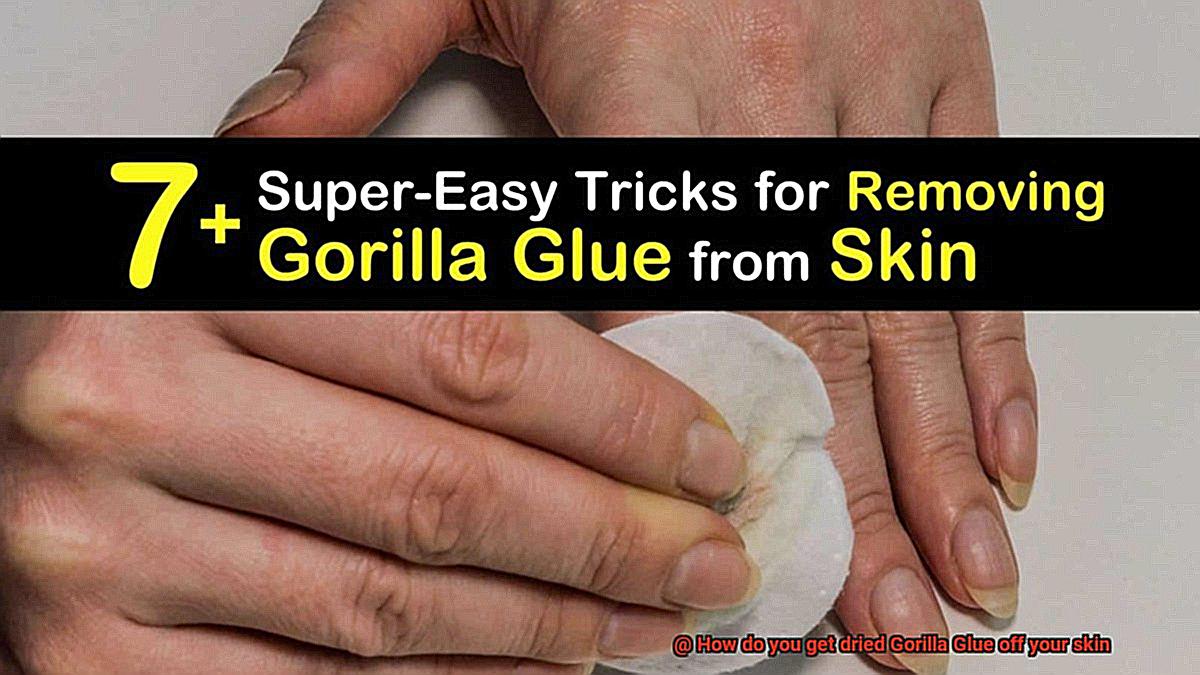
You’ve found yourself in a sticky situation with Gorilla Glue on your skin. Don’t panic. We’ve got you covered with some expert tips on how to protect your skin from further damage and safely remove the glue.
The first step is crucial: resist the urge to pick or peel at the glue. Trust me, this will only make matters worse. Instead, start by gently washing the affected area with warm water and a mild soap. Avoid using harsh chemicals or abrasive scrubbing tools, as these can further irritate your skin. Pat the area dry with a clean towel, being careful not to rub the skin too vigorously.
Once the area is dry, it’s time to soften the glue. Apply a generous amount of moisturizer or petroleum jelly to the affected area and let it sit for a few minutes. This will help loosen the glue and make it easier to remove.
Now comes the fun part – removing the dried Gorilla Glue. Take a gentle exfoliating brush or a soft cloth and begin rubbing the affected area in circular motions. This gentle friction will help break down the bond between the glue and your skin without causing any harm.
If the glue is being stubborn and refuses to budge, try soaking the area in warm water for a few minutes. The warm water will further soften the glue, making it easier to remove.
But what if all else fails? Don’t hesitate to seek medical advice from a healthcare professional. They have additional techniques and specialized products that can safely remove dried Gorilla Glue from your skin without causing harm.
Remember, prevention is always better than cure. When working with strong adhesives like Gorilla Glue, take precautions such as wearing gloves and using barrier creams to protect your skin from direct contact with the glue.
In conclusion, protecting your skin from further damage when dealing with Gorilla Glue requires gentle washing, moisturizing, and careful removal techniques. By following these steps and taking necessary precautions, you can minimize the potential harm caused by dried Gorilla Glue on your skin and ensure safe removal.
Removing Dried Gorilla Glue With Acetone
We’ve all experienced that dreaded moment when a mishap with Gorilla Glue leaves us sporting an unsightly adhesive accessory on our skin. But fear not. Armed with the right knowledge and a trusty bottle of acetone, you’ll bid farewell to that sticky situation in no time.
Acetone, also known as propanone, is a powerful solvent renowned for its ability to break down tough substances. When it comes to removing dried Gorilla Glue from your skin, acetone is your secret weapon. It works by dismantling the chemical bonds in the glue, making it a breeze to wipe away.
Now, here’s the crucial part – remember to use acetone exclusively on your skin and avoid contact with clothing or other surfaces. Trust me, you don’t want to end up with an unintentional hole in your favorite shirt. Prior to diving in headfirst, I recommend conducting a small patch test on a discreet area of your skin to check for any adverse reactions or allergies. It’s always better to be safe than sorry, right?
Once you’ve obtained the clearance, grab a cotton ball or pad and saturate it with acetone. Gently rub it onto the affected area, ensuring that the dried Gorilla Glue is thoroughly soaked. Allow the acetone a few minutes to work its magic, diligently penetrating and breaking down the adhesive properties of the glue.
Once the glue has softened, seize a clean cloth or paper towel and wipe away any residue. If stubborn remnants cling on for dear life, repeat the process until your skin is liberated from their grasp. Remember to cleanse your skin thoroughly with soap and water afterward to eliminate any lingering traces of acetone and residue.
Now, I must caution you – acetone can be drying on the skin. So don’t forget to pamper your skin by applying a moisturizer or lotion afterward. Hydration is key, my friends.
But what if acetone is not readily available? Fear not. There are alternatives to explore. Nail polish remover containing acetone or rubbing alcohol can also be effective in removing dried Gorilla Glue. However, bear in mind that these substitutes may not possess the same potency as pure acetone, necessitating a bit more elbow grease to achieve the desired result.
Alternative Methods for Removing Dried Gorilla Glue
We’ve all been there – accidentally getting our hands or skin stuck with stubborn dried Gorilla Glue. But fear not, for there are alternative methods that can save the day. In this article, we will explore different techniques to remove dried Gorilla Glue from your skin, ranging from the powerful acetone to natural options like vegetable oil. Let’s dive in.
Acetone: The Powerhouse Solution
Acetone is a tried and tested method for removing dried Gorilla Glue. It is a powerful solvent that breaks down the adhesive, making it easier to remove. Look for nail polish removers with high acetone concentrations. Soak a cotton ball or pad with acetone and gently rub it over the affected area. Allow the acetone to sit for a few minutes to soften the glue before peeling it off with a soft cloth or your fingers. Rinse thoroughly with warm water and mild soap.
Vegetable Oil: Nature’s Helper
If you prefer natural alternatives, vegetable oil can be used to loosen dried Gorilla Glue. Apply a generous amount of oil onto the affected area and let it sit for a few minutes. Massage the oil into the glue using gentle circular motions until it starts to dissolve. Use a cloth or your fingers to lift off the softened glue, then wash your skin with warm soapy water to remove any residue.
Warm Soapy Water: Simplicity at its Best
Sometimes the simplest solutions are the most effective. Fill a basin or sink with warm water and add a few drops of mild dish soap or hand soap. Soak the glued skin for 10-15 minutes, allowing the warm water to soften the glue. Gently rub and peel away the adhesive using your fingers or a soft cloth. Rinse your skin with clean water to remove any soap residue.
Petroleum Jelly: A Household Staple
Another household staple, petroleum jelly (Vaseline) can help break down dried Gorilla Glue. Apply a thick layer of jelly onto the affected area and let it sit for at least 30 minutes. Once the glue has softened, gently rub or scrape it off with your fingers or a soft cloth. Wash your skin with warm soapy water afterward to remove any remaining residue.
Warm Vinegar Solution: The Acidic Aid
Vinegar, known for its versatile uses, can also aid in removing dried Gorilla Glue. Create a warm vinegar solution by mixing equal parts warm water and white vinegar in a bowl or basin. Soak the affected area for 15-20 minutes. The acidity of the vinegar helps break down the adhesive, making it easier to remove. After soaking, use your fingers or a soft cloth to gently rub and peel away the glue.
Taking Precautions When Using Adhesives
Adhesives are mighty tools for sticking things together, but their power comes with potential hazards. To ensure safety and effectiveness, it’s crucial to take precautions when using adhesives.
- Read and Follow Instructions: Always start by reading and following the instructions provided by the adhesive manufacturer. These guidelines offer valuable information about proper usage and safety precautions. Pay attention to warnings and special handling instructions mentioned on the product packaging.
- Wear Protective Clothing: Protect yourself by wearing gloves and safety glasses when working with adhesives. These accessories shield your skin and eyes from direct contact with the adhesive, reducing the risk of accidents or injuries.
- Work in a Well-Ventilated Area: Many adhesives release strong fumes that can be harmful if inhaled excessively. Ensure good ventilation by working in a well-ventilated area. This helps dissipate the fumes and minimizes exposure, ensuring your safety.
- Keep Away from Children and Pets: Some adhesives may contain toxic substances that can be dangerous if ingested or mishandled. Store adhesives in a cool, dry place, away from direct sunlight and heat sources. Remember to tightly seal containers after use to prevent drying or leaking.
- Conduct Patch Tests: Before applying adhesive to a larger surface, always conduct patch tests or test small areas. This is particularly important for sensitive skin or when using unfamiliar adhesives. By doing so, you can avoid unexpected allergic reactions or skin irritations.
- Proper Storage and Handling: Store adhesives properly to maintain their effectiveness and prevent accidents. Follow the manufacturer’s instructions for storage temperature and conditions. Avoid using excessive amounts of adhesive to minimize spills and accidental contact with the skin.
- Seek Medical Attention if Necessary: If you accidentally get adhesive on your skin and experience discomfort, irritation, or allergic reactions, don’t hesitate to seek medical attention. Consulting a healthcare professional can provide appropriate guidance and treatment.
Seeking Professional Medical Advice
When it comes to dealing with dried Gorilla Glue on your skin, seeking professional medical advice is crucial. Gorilla Glue is not your average adhesive – it’s a tough customer that can bond surfaces together like nobody’s business. And when it dries on your skin, it becomes a formidable opponent that can be a real pain to remove without causing further damage. That’s why it’s essential to consult with a medical professional who knows their stuff when it comes to skin-related issues.
Here’s why seeking professional medical advice is the way to go:
- Expertise: Medical professionals, like dermatologists or healthcare providers, have seen it all when it comes to skin conditions and injuries. They’re like superheroes who can assess the severity of your Gorilla Glue conundrum and provide you with the best course of action for safe removal.
- Personalized care: By consulting with a medical expert, you get personalized care tailored to your unique needs. They’ll take into account factors like your skin type, any pre-existing conditions or allergies you may have, and even potential interactions with medications. It’s like having a personal skincare guru guiding you through this sticky situation.
- Avoid unintended consequences: While DIY remedies or internet tips might seem tempting, they can potentially make matters worse and leave you with irritated skin or even burns. Harsh chemicals or abrasive techniques can cause further damage, leaving your skin vulnerable to infection or unsightly scars.
So, when it comes to removing dried Gorilla Glue from your skin, don’t take chances with your precious skin. Let the experts assess your situation and provide you with the safest and most effective method for saying goodbye to that stubborn glue. Trust me, your skin will thank you.
Repeating the Removal Process
Today, we embark on a deep dive into the world of adhesive removal, specifically the dreaded Gorilla Glue on your skin. We all know the frustration of a DIY project gone awry, leaving us in a sticky situation. We hold the key to freeing your skin from this tenacious grip. Join us as we uncover the power of repeating the removal process and liberate ourselves from the clutches of Gorilla Glue.
Know Your Opponent:
Gorilla Glue means business. Its formidable adhesive properties demand a strategic approach. A single attempt won’t suffice; repeating the process is essential to break down and loosen its unrelenting bond.
Soak and Massage:
Begin by lavishing your skin with tender care. Immerse the affected area in warm soapy water or apply a nourishing lotion. This gentle treatment softens the glue, rendering it more pliable. Employ a soothing massage to coax the glue into relinquishing its hold. Remember, patience is paramount.
Peel with Caution:
If the glue begins to yield, cautiously peel it off using your fingertips or a blunt object like a spoon or credit card. Exercise caution; never force it. If resistance persists, revert to step 2 and repeat the soaking and massaging process for another opportunity at freedom.
Level Up with Solvents:
In cases where warm soapy water falls short, enter acetone or nail polish remover—your secret weapons against stubborn Gorilla Glue remnants. These solvents work wonders by dismantling the adhesive properties of the glue. Apply them with a cotton ball or pad, allowing them to work their magic for several minutes before gently wiping or peeling off the softened glue.
Rinse and Rejoice:
After employing solvents, thoroughly rinse the area with water to eliminate any residue and prevent skin irritation. And rejoice. When that stubborn glue finally relinquishes its grip, take a moment to revel in your triumph. You’ve done it.
Caring for Your Skin After Removal
You’ve successfully removed dried Gorilla Glue from your skin. Now, it’s time to give your skin the love and care it deserves after this sticky ordeal. In this blog post, we’ll guide you through the essential steps to properly care for your skin post-removal. Let’s dive in.
Step 1: Gentle Cleansing
Start by washing the affected area with mild soap and lukewarm water. Allow the water to gently cascade over your skin, soothing away any remnants of the glue. Avoid using hot water, as it can further dry out your skin. Gently pat your skin dry with a clean towel, ensuring you don’t rub the area vigorously to prevent irritation.
Step 2: Soothing Moisture
After cleansing, delicately apply a generous amount of a soothing moisturizer or cool aloe vera gel to the treated area. Imagine this moisture seeping into your skin like a refreshing drink, hydrating and replenishing it. This will not only provide relief but also reduce redness and inflammation caused by the glue.
Step 3: Protect and Heal
To create a protective barrier and promote faster healing, carefully apply a thin layer of healing ointment, such as petroleum jelly or an antibiotic cream, to the affected area. Picture this ointment acting like a guardian, shielding your skin from external irritants while allowing it to heal.
Step 4: Hands-off Approach
Resist the temptation to pick or peel any loose skin or scabs that may have formed. Instead, envision your skin healing naturally, like delicate threads weaving together to form a seamless tapestry. By letting it be, you prevent scarring or infection and allow your skin to restore itself.
Step 5: Seek Medical Attention if Needed
If you experience persistent pain, redness, swelling, or signs of infection, don’t hesitate to seek medical attention. Think of a healthcare professional as your trusted guide on this healing journey. They can assess the situation and provide appropriate treatment if necessary.
Step 6: Keep It Clean and Dry
Throughout the healing process, imagine your skin as a precious gem that needs gentle care. Keep the treated area clean and dry, avoiding excessive moisture or exposure to harsh chemicals that can irritate your skin. Allow it to breathe and rejuvenate.
CoNOAlIFCBQ” >
Also Read: How do you remove dried Gorilla Glue?
Conclusion
Removing dried Gorilla Glue from your skin can be quite the challenge, but fret not. There are effective methods that will come to your rescue in no time at all.
Prepare yourself for a battle against this stubborn adhesive by gathering some common household items and summoning just a pinch of patience.
One option is to immerse the affected area in warm, soapy water for several blissful minutes. Let this liquid embrace soften the grip of Gorilla Glue on your precious skin, making it easier for you to delicately peel it away.
An acetone-based nail polish remover or rubbing alcohol can be your trusty sidekick in this sticky situation. Dab a modest amount onto a cotton ball and embark on a gentle rubbing expedition, watching as the glue gradually dissolves before your eyes.
Once the adhesive has surrendered, remember to cleanse the area thoroughly with water to ensure no residue remains.
For those with delicate skin that craves a softer touch, olive oil or coconut oil can be your knight in shining armor.

